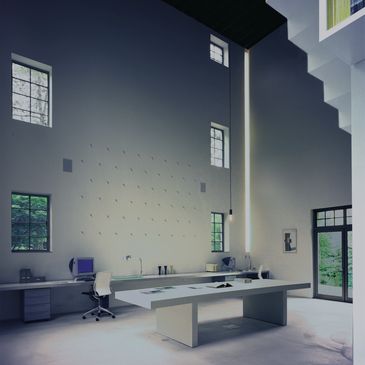MORRIS SATO STUDIO - PROFILE

ARCHITECTURE
DESIGN & TECHNOLOGY
ARCHITECTURE
London born , Irish & US national—Michael Morris and Tokyo born, Japanese native—the late Yoshiko Sato, independently trained in the fine arts prior to studying architecture at The Cooper Union . Graduating in 1989, the pair began teaching at architecture and fine art colleges, completed their professional training, and pursued their post-graduate studies (in Ireland & Harvard GSD).
Following years of independent moonlighting, in 1996 the pair became the Morris Sato Studio in
New York City.

PUBLIC ART
DESIGN & TECHNOLOGY
ARCHITECTURE
Widely recognized for creating 'otherworldly' projects, Morris Sato Studio infuses temporal and spatial dimensions with equal parts —material, light and air, into formally restrained, highly crafted and detailed work that seamlessly integrates innovative technology with advanced means and methods.
In 2006, while teaching at Columbia University the partners launched their Studio's cosmic research arm Space Exploration Architecture (now SEArch+ www.spacexarch.com ) to connect, investigate, and explore life beyond planet Earth.
DESIGN & TECHNOLOGY
DESIGN & TECHNOLOGY
DESIGN & TECHNOLOGY
LightShowers, a touchstone of the Studio’s applied research, seeks to fuse lighting, material, technology, and fabrication into holistic experiences that support health and wellbeing. Sato Morris' immersive, interactive multimedia installation was inspired by cardiac care protocols of medical researchers at Columbia Presbyterian Hospital, which integrated bio-feedback technology, LEDs, and video projection to align human breath at rest with the universal rhythms of nature. Presented internationally, LightShowers has been experienced by more than 200,000 visitors.
RESPONSIBILITIES & REUSE

“Designing for a world already full,” Morris Sato critically engages in ground-up, adaptive-reuse, and conservation projects. In dialogue with the past and learning from the ready-made, the Studio works both intuitively and deliberatively—like a gardener—cultivating opportunities that inspire wonder and safeguard present and future ecologies. Through collaborative, multi-generational efforts, Morris Sato honour the social contract of giving something back.


PLACES & COMMUNITIES
INTERIORS
URBAN SUSTAINABILITY
CIVIC LANDSCAPES

Morris Sato interior designs employ the Chinese-Japanese 'borrowed landscape' garden principle to synchapate light, air, matter, texture, and colour with the environments beyond.
CIVIC LANDSCAPES
URBAN SUSTAINABILITY
CIVIC LANDSCAPES

By extending the 'borrowed landscape' principle into the public realm, the Studio's work aims to engage all of the senses combining nature and man-made to celebrate the ephemeral.
URBAN SUSTAINABILITY
URBAN SUSTAINABILITY
URBAN SUSTAINABILITY

Recognizing our climate emergency, Morris Sato is committed to implementing The UN's Sustainable Development Goals in support of all life forms and communities around the globe.
MUSEUMS & GALLERIES

Parallel to their collaborative public art installations, Morris Sato has designed numerous permanent museum and gallery spaces as well as archival environments. Their independent art-architectural training, combined with a long-standing commitment to working with the fine and performing arts, has earned the Studio international recognition and critical acclaim for refined works that offer “persuasive evidence for the existence of aura.”

EXHIBITION DESIGN & INSTALLATIONS
CULTURAL
COMMERCIAL
COMMERCIAL

Morris Sato's gardening tropes are most delightfully experienced in the Studio's extensive art museum displays, temporary installations, and exhibition designs.
COMMERCIAL
COMMERCIAL
COMMERCIAL

The commercial spin-offs of Morris Sato Studio's extensive museum work are their award-winning trade show pavilions, showrooms, medical and hospitality prototypes and facilities.
CORPORATE
COMMERCIAL
CORPORATE

For American Express Morris Sato narrated the Corporation's 200+ year economic history, infusing executive spaces with original artifacts, holography, interactive displays, and branding.
EXHIBITION DESIGN GALLERY
HEALTHCARE & WELLBEING

Morris Sato Studio is committed to improving existing and innovating next-generation medical facilities to become increasingly humane, resilient, and sustainable spaces for healing.


Balancing hygienic and healthy materials with functional design, Morris Sato equally strives to create purposeful and empathetic places that are accessible, inclusive, and welcoming.
ACTIVISM & ADVOCACY

COLLABORATION
COLLABORATION
COLLABORATION
Morris Sato Studio is grounded in collaboration, actively leading and contributing to community and non-profit projects.

TEAMWORK
COLLABORATION
COLLABORATION
As a society, we invest in one another, honour diversity, and open pathways to inclusion and accessibility for all.

SAFEGUARDING
COLLABORATION
SAFEGUARDING
Striving to inspire, our Studio is dedicated to serving all people and ethically protecting human rights and the basic need for shelter..
RESEARCH & REFLECTION












FEATURED PROJECTS : SHELTER ISLAND HOUSES, NY, USA


YN-13 HOUSE
VIDEO: YN-13 HOUSE - MORRIS & SATO
SOULA HOUSE
SOULA HOUSE
FEATURED PROJECT #3 : 2008 BEIJING OLYMPICS OPENING CEREMONY
"TAIKONAUT" COSTUME DESIGN - OPENING
"TAIKONAUT" COSTUME DESIGN - OPENING
"TAIKONAUT" COSTUME DESIGN - OPENING

"CYBORG" COSTUME DESIGN - FINALE
"TAIKONAUT" COSTUME DESIGN - OPENING
"TAIKONAUT" COSTUME DESIGN - OPENING

CONTACT : MORRIS SATO STUDIO
studio@morrissato.com
MORRIS SATO STUDIO LLP
NEW YORK - DUBLIN
+1.212.228.2832 / 9179451880 USA +353 0833619986 IRL / WhatsApp

This website uses cookies.
We use cookies to analyze website traffic and optimize your website experience. By accepting our use of cookies, your data will be aggregated with all other user data.